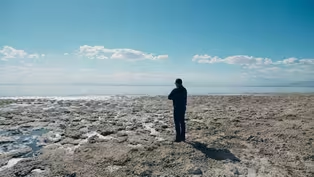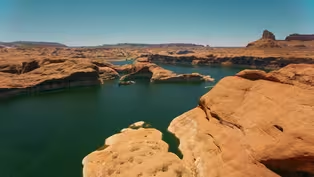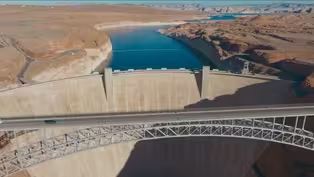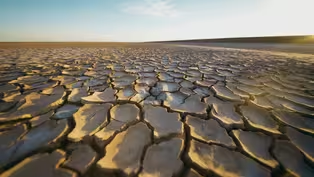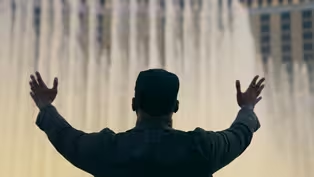
Tag, You're It: Tracking the Grand Canyon's Toughest Fish
Clip: Season 2 Episode 5 | 4m 35sVideo has Closed Captions
USGS biologists tag humpback chub to monitor life in a changing Grand Canyon river.
Biologist Lindsay Hansen and her USGS team work day and night to study the federally threatened humpback chub in the Grand Canyon. Using PIT tags, they track fish growth and migration to understand how this resilient species adapts to cold dam flows and warming tributaries like the Little Colorado. Their efforts offer a glimpse of hope in an altered ecosystem.
Problems playing video? | Closed Captioning Feedback
Problems playing video? | Closed Captioning Feedback

Tag, You're It: Tracking the Grand Canyon's Toughest Fish
Clip: Season 2 Episode 5 | 4m 35sVideo has Closed Captions
Biologist Lindsay Hansen and her USGS team work day and night to study the federally threatened humpback chub in the Grand Canyon. Using PIT tags, they track fish growth and migration to understand how this resilient species adapts to cold dam flows and warming tributaries like the Little Colorado. Their efforts offer a glimpse of hope in an altered ecosystem.
Problems playing video? | Closed Captioning Feedback
How to Watch Human Footprint
Human Footprint is available to stream on pbs.org and the free PBS App, available on iPhone, Apple TV, Android TV, Android smartphones, Amazon Fire TV, Amazon Fire Tablet, Roku, Samsung Smart TV, and Vizio.
Buy Now

Surprising Moments from Human Footprint
Do you think you know what it means to be human? In Human Footprint, Biologist Shane Campbell-Staton asks us all to think again. As he discovers, the story of our impact on the world around us is more complicated — and much more surprising — than you might realize.Providing Support for PBS.org
Learn Moreabout PBS online sponsorship(energetic music) (Shane) This is Lindsay Hansen.
She finds artistic inspiration in the epic landscapes of the Grand Canyon.
♪ (boat engine humming) She’s also a biologist studying the Colorado River’s unique fish community for the USGS.
♪ (Lindsay) Okay, sweet.
So, what we have here are some Humpback chub and some flannelmouth suckers.
(Shane) Ooh.
(soft music) Lindsay’s been working here since 2019.
She’s interested in all the fish, but she’s got a few favorites.
I’m gonna assume that is a Humpback chub given the humpbacked-ness of it.
(Lindsay) Absolutely.
Yeah.
So, this is the Humpback chub, the fish that we are out here to study.
(Shane) Okay.
(Lindsay) And this is a really good-looking adult fish.
(mellow music) (Shane) The humpback chub is a federally threatened species.
Lindsay’s catching them to collect data on their growth and reproduction, and, ultimately, to help them survive in a changing river.
(Lindsay) On these trips, we administer a PIT tag.
It’s called a passive integrated transponder tag.
(Shane) It’s the same technology you might use to microchip your pet.
(Lindsay) And then the numbers that you give me will allow us later to see how much the fish grew.
So, if we catch it next time, we’ll be able to see where it moved to.
And we can learn a lot about the fish that way.
(Shane) In a few seconds, the fish is measured, tagged, and sent on its way.
(Lindsay) We multiply that by thousands of individuals, we can learn a lot about how their population is doing.
(upbeat music) (Shane) It’s a huge team effort, with multiple survey trips per year.
♪ (Lindsay) We are on the water for 21 or 22 days per trip.
We will send these small silver boats called ospreys out to collect fish.
They will bring them back to what we call our processing boats, kind of like our mother ship.
We’re fishing day and night, we’re processing fish day and night.
We’ll take a little break to, you know, sleep on the river banks together, and then the next day, we get up and we do it all again.
(Shane) That’s hardcore.
(Lindsay) It’s very hardcore.
Yeah.
(Shane) All this hard work has yielded important discoveries.
(Lindsay) One of those big takeaways is that these fish spawn more often when it’s warmer.
(Shane) The chub evolved in a river with huge temperature swings.
Fed by snowmelt, the river ran cold in the spring and early summer.
(Lindsay) But then when there’s not very much water and there’s hot sunlight directly hitting it, it heats up quite a bit.
(Shane) That’s when the chubs really chub.
(Lindsay) Exactly.
Yeah.
Yeah.
They chub really hard in the summer, and then in the winter, when they’re kind of shivering, they don’t grow very much.
(contemplative music) (Shane) These days, the river is cold year-round; the Glen Canyon Dam generates power by releasing water from the bottom of Lake Powell, where the water is frigid.
Luckily, the chub have a Plan B.
(Lindsay) They often will migrate into and out of the Little Colorado River in order to go up there and spawn and then come back out.
(soft guitar music) (Shane) The Little Colorado is an undammed tributary that joins the Colorado River in the heart of the Grand Canyon.
(Lindsay) The spring that feeds this river is a calcium carbonate spring and it creates this kind of beautiful blue water.
(Shane) The Little Colorado is also milder than the Colorado River itself, allowing the chub to spawn.
It’s a fraction of their former breeding grounds, but the fish are making it work.
And Lindsay’s still hopeful about their future.
(Lindsay) They’re up running rapids, they’re going down rapids.
They’re a little bit tough.
If they can thrive and survive in this really wacky system... -Yeah.
-...then I think we can too.
♪ (Shane) The humpback chub flourished in the untamed Colorado, and maybe we could learn to live with a wilder river, too.
♪ But we’ve got a lot of unlearning to do.
Even here in the grandest of landscapes, humanity’s impacts are impossible to ignore.
♪
The Beach Boys Played Here. Now It’s a Toxic Dust Bowl.
Video has Closed Captions
Clip: S2 Ep5 | 5m 13s | Toxic dust, dead fish, and vanishing water — what happened to California’s inland sea? (5m 13s)
The Dam Truth: What Glen Canyon Tells Us About a Drying West
Video has Closed Captions
Clip: S2 Ep5 | 9m | The Glen Canyon Dam promised water and power — but the river had other plans. (9m)
Video has Closed Captions
Preview: S2 Ep5 | 30s | A journey down the Colorado River reveals the ripple effects of humanity’s quest to conquer water. (30s)
Reviving the River: Hope Returns to the Colorado Delta
Video has Closed Captions
Clip: S2 Ep5 | 4m 59s | Aída Navarro joins the fight to revive the Colorado River Delta — and hope is flowing again. (4m 59s)
Vegas vs. the Desert: Plumbing the Impossible
Video has Closed Captions
Clip: S2 Ep5 | 11m 19s | Las Vegas defies the desert with epic engineering — but at what long-term cost? (11m 19s)
Providing Support for PBS.org
Learn Moreabout PBS online sponsorship
- Science and Nature

Explore scientific discoveries on television's most acclaimed science documentary series.

- Science and Nature

Capturing the splendor of the natural world, from the African plains to the Antarctic ice.












Support for PBS provided by:
